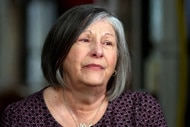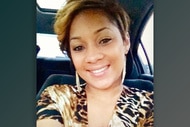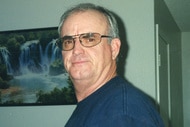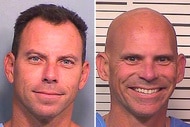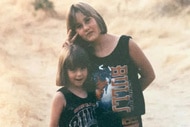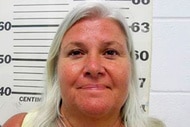Create a free profile to get unlimited access to exclusive videos, breaking news, sweepstakes, and more!
Why Was George Franklin’s Murder Conviction In The Susan Nason Case Overturned?
The new Showtime series "Buried" looks at the role represeed memories played in the lives of George Franklin and his daughter Eileen Franklin.

In 1990, a man convicted of killing his young daughter's school-age friend in a case that riveted the country walked away a free man six years later.
George Franklin was convicted of first degree murder in November 1990 for the death of eight year-old Susan Nason in 1969, based largely on the testimony of his then-29 year-old daughter, Eileen Franklin-Lipsker. Franklin-Lipsker testified at her father's trial that she recovered her memory of witnessing the brutal murder of Nason in 1989, when her own daughter was about Nason's age. (Franklin's ex-wife and other daughter also testified against him at trial.)
As recounted by the Los Angeles Times, Franklin-Lipsker testified that, looking at her own daughter, she suddenly recalled that her father had picked up Nason in his van in 1969 while out with his daughter, drove them to an isolated location, "climbed on top" of Nason on a mattress in the back of the van and sexually assaulted her. When Nason wouldn't stop crying after the assault, Franklin-Lipsker testified, she saw her father smash Nason's skull in with a rock.
Nason's body was recovered nearly two months after her disappearance under a mattress near a reservoir about 15 miles from where the Nasons and Franklins lived. No suspects were arrested in the case until Franklin-Lipsker came forward about her recovered memories 20 years later.
Franklin served nearly five years of his life sentence before, in April 1995, federal Judge Lowell Jensen vacated Franklin's conviction. He ruled that the trial judge had made several constitutional errors that “had a substantial and injurious effect on the jury’s verdict," the New York Times reported.
The trial judge's first legal error, the federal court ruled, was allowing prosecutors to present evidence that Franklin-Lipsker had visited her father in prison after his arrest and urged him to tell her the truth. Franklin remained silent, pointing to a sign in the room that read "Conversations May Be Monitored." Prosecutors argued to the jury multiple times that his silence in the face of his daughter's accusations were evidence of his guilt.
In the wake of Franklin's conviction, according to court documents, his lawyers discovered by reading Franklin-Lipsker's book about the case that the prosecutors had been aware of her plan to try to get her father to confess on the day in question and that prison officials made special arrangements for her visit to accommodate her schedule. Neither was disclosed in pre-trial discovery.
The U.S. Supreme Court has repeatedly ruled that any person's silence in the face of police accusations after they've been read their Miranda rights (i.e., been told they have the right to remain silent) cannot be used as a tacit admission of guilt. By pointing to the sign, the appeals court ruled, Franklin had made clear "the desire not to talk to the government was his motivating factor in remaining silent."
Further, the appeals court said, the prosecutor's knowledge of Franklin-Lipsker's plan to confront her father, his efforts to expedite the visit and jail officials' unusual efforts to accommodate her schedule also violated Franklin's rights. By involving itself in an effort to obtain a post-arrest confession from Franklin in the absence of his counsel, the state should have forfeited the right to use it (or the absence of it) as evidence of his guilt.
And, finally, the appeals court ruled that the trial judge made the wrong determination when he said the defense could not present evidence that details about the murder, which Franklin-Lipsker testified that she remembered, were in the public domain prior to her statements to police. Prosecutors alleged at trial that several pieces of information recalled by Franklin-Lipsker were not known to anyone but the police, but the defense was not allowed to present evidence that many of those statements — including that Nason was wearing a small ring that was smashed, that evidence at the scene indicated she suffered a head injury after being struck with a rock, and that there were brown shoes involved — were widely reported in the local media. The failure to allow evidence rebutting that testimony violated Franklin's right to a fair trial, the court ruled.
The court also noted that the prosecutors' failure to turn over evidence of Franklin-Lipsker's efforts to expunge her earlier prostitution conviction prior to reporting the murder were legally "problematic," as were allegations that Franklin-Lipsker committed perjury and tried to suborn her sister to commit perjury to disprove the claims that she had read media coverage about the murder. But, the court ruled, the first three errors were enough to vacate Franklin's 1990 conviction.
Prosecutors were mixed about their willingness to retry Franklin. In December 1995, the LA Times noted, prosecutors understood that the public perception of the reliability of "repressed memories" like Franklin-Lipsker's had shifted. And, perhaps more to the point, the defense was then specifically allowed to present evidence that much of what she had originally testified to, which prosecutors had originally argued could only have been known by an eyewitness to the murder, had been reported in the local media.
By February 1996, however, prosecutors had decided to move forward with a retrial, according to the San Francisco Chronicle, and a trial date was set for Sept. 16, 1996.
That's when the defense filed motions to disqualify the original prosecutors from taking part in the trial. As part of those motions, reported the Associated Press, the defense revealed that Franklin-Lipsker had claimed in August 1990 to have recalled the details of two others murders her father had allegedly committed with her as a witness.
Franklin-Lipsker told prosecutors that she remembered being a teenager in the mid-70s, driving in the car with her father when a young woman got in; her father, said said, later chased the woman through the woods and strangled her with a belt.
Prosecutors were able to eliminate all but one unsolved murder, and showed Franklin-Lipsker pictures an array of photos from unsolved cases of that era — including the photo of 18-year-old Veronica Cascio, who had been murdered in nearby Pacifica in 1976. Franklin-Lipsker identified Cascio and, later, the scene as the murder said she witnessed.
Cascio was one of five women whose rapes and murders in the first half of 1976 had been connected to an unknown assailant dubbed the "Gypsy Hill Killer"; detectives had suspected, after Franklin-Lipsker connected him to the Cascio case, that Franklin might be involved in all.
However, semen samples still existed from the Cascio crime scene, and Franklin was ruled out. In 1991, Franklin-Lipsker then claimed her godfather — who she had also accused at her father's trial of raping her with her father's participation, in a memory she said she also recovered — was involved in that and another murder she witnessed her father commit at age 15. semen samples from her godfather also did not match the ones from the Cascio crime scene and prosecutors were never able to match her second murder description to any open case. (Cold case detectives matched the DNA from the Cascio case to convicted rapist Rodney Halbower in 2014, and Halbower was convicted of that and one of the other Gypsy Hill murders in 2017.)
The defense alleged that Franklin-Lispker's other, disproven accusations against her father were "irrefutable evidence that Eileen Franklin's 'memory' is an unstable machine that generates wildly contradictory images," according to the AP.
Then in March 1996, Franklin's other daughter, Janice Franklin — who had testified against him at the first trial and believed Franklin-Lipsker's accusations — revealed to prosecutors that she and her sister had lied on the stand about not being hypnotized at her father's first trial, the San Francisco Chronicle reported at the time. As required by law, prosecutors provided that information to the defense in discovery before his second trial.
At a pretrial hearing in June 1996, after a judge ordered prosecutors to grant her immunity to protect her from a perjury conviction, Janice Franklin testified that her sister had confided in her in 1989 that she had actually recovered her memories as a result of hypnosis, and that the sisters discussed the fact that admitting that Franklin-Lipsker had been hypnotized to recover the memories would affect the case against their father. (Franklin-Lipsker had testified that she'd never been hypnotized to recover her memories and that prior statements, asked about at the trial, to her mother and her brother about recovering her memories due to hypnosis were false.)
That's because a 1982 state Supreme Court ruling barred the testimony of all witnesses who had been hypnotized — though a 1984 law, rarely used, provides for some limited circumstances under which such testimony would be allowed. Franklin-Lispker's original testimony would not have qualified for that loophole. Janice Franklin said she came forward, reported the Chronicle, in the hopes that the law that allowed hypnotized testimony might be broadened. (Several contemporaneous audiotapes used in "Buried" suggested Janice Franklin's motives were less advocacy-minded.)
The defense planned to argue that the use of hypnosis to recall the murder would prevent Franklin-Lipsker from testifying at her father's retrial.
On July 3, 1996, prosecutors moved to drop all the charges against George Franklin, the Chronicle reported, and the request was granted. Franklin was released later that day.
He was never retried.

